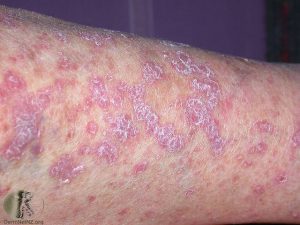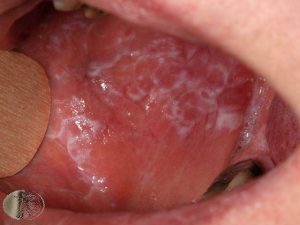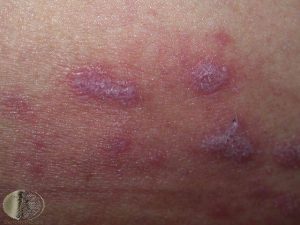
Lichen planus (LP) is a relatively common skin condition that can appear on the skin of many different areas of the body and can also appear on the scalp, nails, genitals, or inside the mouth. This condition is not contagious, and it is not a type of cancer.
On the skin, lichen planus usually causes small bumps that are flat-topped, shiny, and red or purple. They often have tiny white lines on the surface called Wickham’s striae. The most common area for these bumps to appear are the wrists, ankles, and lower back, but they can appear anywhere. These bumps can be itchy or painful. Inside the mouth, there may be redness, patches of tiny white dots or white lace-like lines, peeling, or painful sores. LP may affect fingernails, which can cause ridges, grooves, splitting, thinning, or loss of nails that may be temporary or permanent. In the scalp, the condition has the name lichen planopilaris and affects the hair. There may be redness, irritation, tiny bumps, hair loss, and scarring.

Anyone can get lichen planus, but it is most common in middle-aged adults. Oral LP more commonly affects women than men. Some medications can cause a rash that looks like LP, which include some diuretics, antimalarials, gold salts, and beta blockers, among others. Sometimes a metal filling in the mouth may be the cause. There may also be a link between hepatitis C and lichen planus, especially in the erosive form inside the mouth.
Your dermatologist will often be able to diagnose lichen planus by physical exam, but frequently a skin biopsy may be necessary to clarify or confirm the diagnosis. Your dentist may find lichen planus in the mouth.
Treatment for lichen planus includes the following options:
- Topical corticosteroid cream or ointment
- Antihistamines to help reduce itching
- Corticosteroids (prednisone) as pills or as a shot
- Tacrolimus ointment or pimecrolimus cream
- Immunosuppressant medications given as a prescription pill

In most cases lichen planus will go away within 2 years. About 20% of people affected may have a second occurrence. For some people, the condition may last for many years, especially with the form inside the mouth. This form can be very difficult to treat. In addition to prescription medication, some recommendations for the oral form of LP include:
- Do not smoke, do not chew tobacco, do not drink alcohol
- Get a screening for oral cancer every 6-12 months with your dentist
- Brush your teeth twice daily and floss daily
- Avoid spicy foods, citrus fruits and juices, tomatoes or tomato products, salty snack foods, and drinks that contain caffeine (coffee, tea, and soda)
